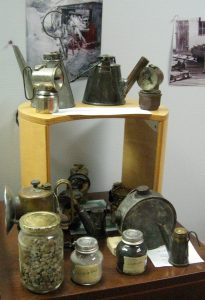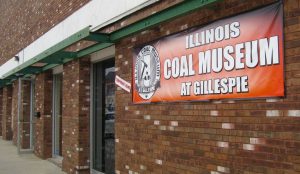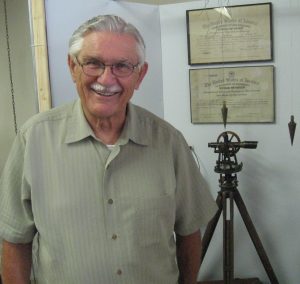
Miners’ story will be told
By CARL GREEN
Illinois Correspondent
GILLESPIE, IL – The Metro-East and Southwestern Illinois are steadily becoming a vital region for maintaining and showing the history of labor unions and their members.
The Belleville Labor and Industry Museum is a strong presentation of the city’s industrial past, and the Mother Jones Monument and Museum in Mt. Olive tell the story of one of America’s most inspiring labor leaders.
Now a third entry in that group is making itself known – the Illinois Coal Museum at Gillespie, in Macoupin County just north of the Metro-East.
It’s not quite ready for prime time, but it has made great strides already since its organizers gained access to the building in June, and much more development is planned.
The Gillespie Coal Mining Heritage Commission, led by retired mine workers who call themselves the “gray-haired crew,” is creating the museum for this stated purpose: “…to collect, preserve, study, exhibit and stimulate appreciation for and advance knowledge of the role of coal mining in Illinois.”
You could also say it’s to clean out Jim Alderson’s basement, but that might be selling the effort short. Right now, the museum is full of interesting things that Alderson, one of the retirees, has collected over the years, including items from auctions, yard sales and flea markets, and old tools that required research just to figure out how they were used.
BIG PLANS
The Commission has developed an ambitious plan that could eventually include large outdoor displays, displays about the miners, their mines and their unions, and information on the use of coal, environmental issues and the immediate vicinity of Gillespie, once home to nine different mines and a town that grew to a population of 6,000 in the mining boom years and hovers about 3,200 these days.
For now, the museum is confined to a large building at 121 S. Macoupin Street, the main thoroughfare through downtown. The building previously housed a bank and shops and has been vacant since 2004. The city of Gillespie helped the museum secure the building and clean up its mold and asbestos problems.
“This was the biggest dinosaur on the street, so that’s what we decided to tackle – to take it off of the boarded-up rolls and do something with it,” said Dave Tucker, a key member of the museum team.
He recalls the site having three storefronts and a total of five interconnected buildings. “We had to tear everything out and strip this whole building, the teller counters and everything,” he said. “I was the youngest one of the ‘gray-haired crew’ cleaning this place up.”

The museum has a miniature mine shaft entrance, and displays full of genuine mining artifacts, including collections of head gear and the tiny lamps miners wore on their heads so they could see in the darkness.
BUDGET CUT GIFTS
Another miner, Wayne Hinton, built some of the displays, and the museum had some good fortune when it turned out that the state of Illinois had mining information boards available for the asking.
The boards were professionally made for the coal industry office of the Department of Commerce and Economic Opportunity and had been used for school and community presentations.
“They closed that office up when the budget cuts hit a year ago, and these got put in a box,” Tucker said. They were sent to the Department of Natural Resources, which passed them along to the museum, and now the boards are proudly displayed throughout.
Another “gift” from the old coal industry office is a display of children’s art from a calendar contest the office used to sponsor. The museum makers hope to someday reunite the artists for photos with their work.
WHEN TO GO
So it’s not quite a rival to Chicago’s famous Museum of Science and Industry, not yet, but the work goes on. One thing they haven’t nailed down is when the museum will be open to the public.
Right now, the best time to go is between 9 a.m. to 1 p.m. on Tuesdays, Thursdays and Sundays, when the gray-haired crew members are there to work on it. Alderson suggests that during winter, visitors call him at (217) 839-2739 before driving over.

“Until we get everything done, we don’t have regular hours yet,” he said. We need to get our displays laid out better so it tells the story a little better.”
They also hope to make a connection to some of the Route 66 tours that pass through the town. Other ideas are for a miners memorial, a welcome center for the town, a children’s section and a community theater/conference room,
In the meantime, the retired miners are hard at work turning their unruly collection of treasures and cast-asides into a functioning museum.
“It’s a good start,” Hinton said. “We’re trying to make progress the best we can. We call it the ‘gray-haired crew.’ We’re working on it slowly and surely.”
FIRST EVENT
One of the first events at the museum happened on Wednesday, Aug. 3, when the retirees gathered to bestow the United Mine Workers of America endorsement upon Mike Mathis, Democratic candidate for the Illinois House from the 95th District, and also a resident of Gillespie and a former mine worker.
“This is a wonderful place,” Mathis said in his brief remarks. “I’m proud to have it here in this community. And I know you have the cooperation of the city, too and that’s important. This is going to be an important asset to the city. We have a legacy of coal mining in Illinois, and it’s being passed down from generation to generation.”
Then he took the opportunity for a little ribbing of the collector Alderson.
“I can’t believe that your wife let you have all this stuff,” Mathis told him, drawing gales of laughter. “It’s not junk. It’s a lot more than that.”
Alderson was ready with a response, too.
“I’ve got more stuff in the basement,” he said.
The Gillespie Coal Mining Heritage Commission can be contacted c/o Gillespie City Hall, 115 N. Macoupin St., Gillespie, IL, 62033, by email at curator@gillespiecoalmuseum.org or online at gillespiecoalmuseum.org.

